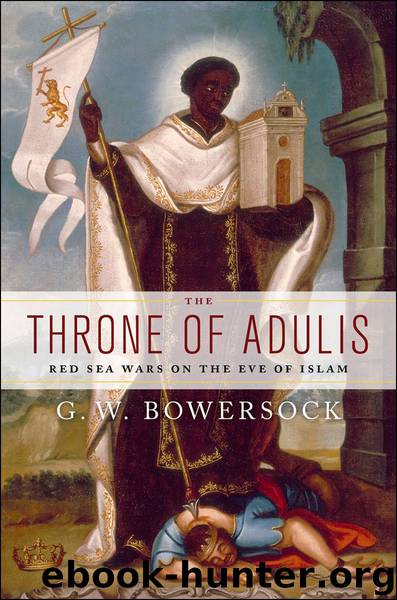Throne of Adulis by Bowersock G.W

Author:Bowersock, G.W.
Language: eng
Format: epub
Tags: Red Sea Wars on the Eve of Islam
Publisher: Oxford University Press, USA
Published: 2013-09-21T16:00:00+00:00
7
THE ETHIOPIAN INVASION OF 525
If Cosmas can be trusted in reporting that he was present at Adulis twenty-five years before he was writing, he was there in 523 or 524, precisely the years in which Symeon of Beth Arsham was doing his best to arouse support for the persecuted Christians in Ḥimyar after the pogrom at Najrān. It is therefore of the greatest interest that Cosmas reports that the Ethiopian negus, Ella Asbeha (Kālēb) was planning at that moment an overseas campaign against the Ḥimyarites. This can hardly be a coincidence. After all, it was Symeon’s intention to summon help for the surviving Christians in Arabia. What is particularly telling in Cosmas’ report is that Kālēb ordered the inscriptions on the Adulis throne and stele to be copied at that very time for his personal reference, and this suggests that he saw his forthcoming invasion in the context of earlier Axumite expeditions overseas.
The most recent of these expeditions had been, as we have seen, Kālēb’s own just five or six years before. In that expedition he installed a Christian king in Ḥimyar, Ma‘dīkarib Ya‘fur. The background for this invasion in about 518 helps to explain the violence that broke out at Najrān in 523, and it needs to be looked at carefully. It has become apparent in recent years that Kālēb’s first intervention in Arabia was not an effort to subvert the Jewish monarchy in Ḥimyar, which had begun over a century before, but to reinforce a Christian presence that had somehow managed to supplant the Jewish rulers and assume control of the country in the early sixth century. Arabian inscriptions reveal a king called Marthad’ilān Yanūf in Ḥimyar between 504 and 509. There is no explicit evidence that he was Christian, but if he is identical with the Marthad, son of Abdkulāl, this might be inferred from the reported Christianity of his father Abdkulāl in Arabic sources. But such a tenuous inference is immensely strengthened by an intriguing fragment from the Byzantine chronicler John Diakrinomenos, who is cited in the Ecclesiastical History of Theodoros Anagnostes.1
The fragment states that the Ḥimyarites, who are described as a client nation of the Persians and dwelling in the extreme south of Arabia, had been Jews from the beginning (anekathen in Greek) when the Queen of the South, who can be understood here, as in the New Testament, to be the biblical Queen of Sheba, went to visit King Solomon. This startling information shows yet again how the Queen’s visit to Jerusalem figured no less significantly in the Arabian tradition than in the Ethiopian, and it indicates a belief, however indefensible, that some Jews had been in the peninsula for a very long time, even before the expulsion from Palestine under Vespasian. John Diakrinomenos clearly believes that the Ḥimyarites had not only been Jews from time immemorial but were still Jews in the early sixth century, since the reigning emperor is identified as Anastasius. The chronicler states that it was in his reign that the Ḥimyarites became Christian, and that they requested a bishop.
Download
This site does not store any files on its server. We only index and link to content provided by other sites. Please contact the content providers to delete copyright contents if any and email us, we'll remove relevant links or contents immediately.
| Buddhism | Christianity |
| Ethnic & Tribal | General |
| Hinduism | Islam |
| Judaism | New Age, Mythology & Occult |
| Religion, Politics & State |
Cecilia; Or, Memoirs of an Heiress — Volume 1 by Fanny Burney(31338)
Cecilia; Or, Memoirs of an Heiress — Volume 3 by Fanny Burney(30935)
Cecilia; Or, Memoirs of an Heiress — Volume 2 by Fanny Burney(30891)
The Secret History by Donna Tartt(16635)
Sapiens: A Brief History of Humankind by Yuval Noah Harari(13059)
Leonardo da Vinci by Walter Isaacson(11907)
The Radium Girls by Kate Moore(10910)
Sapiens by Yuval Noah Harari(4540)
The Wind in My Hair by Masih Alinejad(4426)
How Democracies Die by Steven Levitsky & Daniel Ziblatt(4401)
Homo Deus: A Brief History of Tomorrow by Yuval Noah Harari(4282)
Endurance: Shackleton's Incredible Voyage by Alfred Lansing(3845)
The Silk Roads by Peter Frankopan(3764)
Man's Search for Meaning by Viktor Frankl(3636)
Millionaire: The Philanderer, Gambler, and Duelist Who Invented Modern Finance by Janet Gleeson(3572)
The Rape of Nanking by Iris Chang(3518)
Hitler in Los Angeles by Steven J. Ross(3439)
The Motorcycle Diaries by Ernesto Che Guevara(3338)
Joan of Arc by Mary Gordon(3260)
